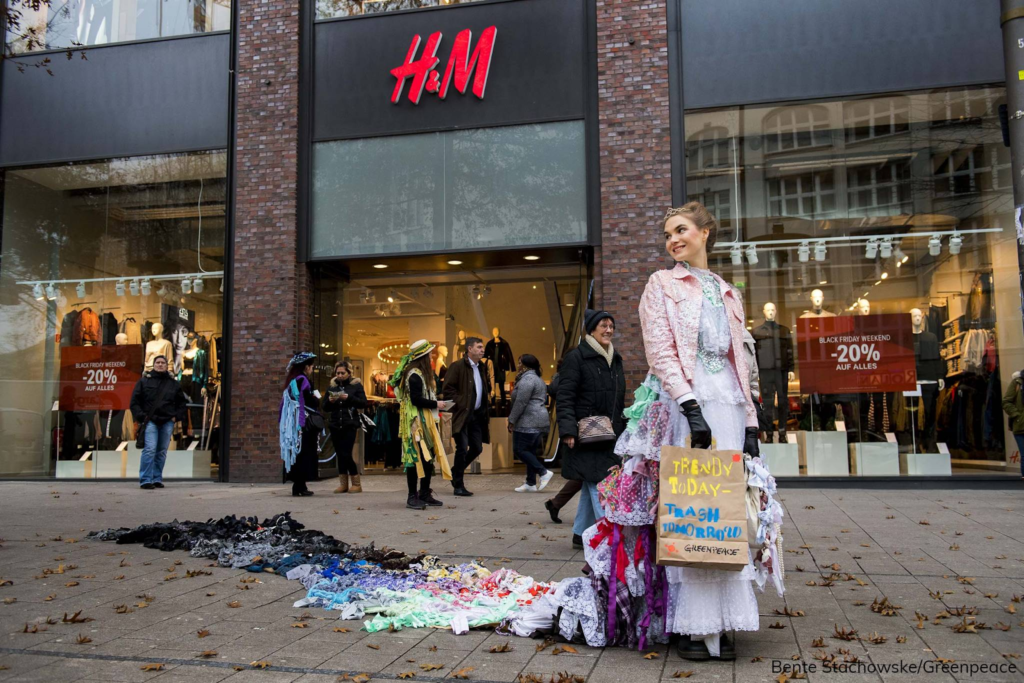Fast Fashion, Thrifting, and Sustainability

Image courtesy of Bente Stachowske/Greenpeace
By Margaret Adams
The rise of fast fashion and commercialized thrifting has quickly entered the conversation surrounding sustainability.
Fast fashion, as defined by Solene Rauturier, is “cheap, trendy clothing that samples ideas from the catwalk or celebrity culture and turns them into garments in high street stores at breakneck speed to meet consumer demand. The idea is to get the newest styles on the market as fast as possible, so shoppers can snap them up while they are still at the height of their popularity, and then, sadly, discard them after a few wears.”
Fashion trends come and go quickly in an age of constant reinvention, so brands that sold these clothes for obscenely cheap became extremely popular. The trend of fast fashion itself allows customers to get used to a stream of constant clothes, coming and going; the effects of fast fashion, which have been seen through the contribution to land waste and perpetuation of sweatshops, have been publicized more recently to deter customers from contributing to it.
“Experts predict that the world’s population will swell to 8.5 billion by 2030 and that GDP per capita will rise by about 2% a year in developed countries and 4% in developing ones,” reported Wall Street Journal.
If the population increases, so will clothing production and waste.
“If these estimates are right and we don’t change our consumption habits, the world will collectively buy 63% more clothing, from 62 million tons a year to 102 million” Boston Consulting Group reports.
The fashion industry is one of the most environmentally harmful industries today. According to Newsweek, the average American throws away approximately 80 pounds of clothing and textiles annually, occupying nearly 5 percent of landfill space.
Not only does fast fashion contribute to landfill space, but many fast fashion companies use sweatshops, which consist of many workers under dangerous and unclean conditions.
H&M released a statement in 2013 promising their textile production workers living wages by 2018:
“It has always been our vision that all textile workers should be able to live on their wage,” H&M said in their statement.
“We believe that the wage development, driven by for example governments in some countries, is taking too long, so we want to take further action and encourage the whole industry to follow. With size comes responsibility, and we have the ability to contribute to change,” said the company.
Since then, H&M lessened its goal to having “improved wage management systems” in place, and their statements about the subject became more vague.
“A number of elements in those updates seem to be generalist, not concrete enough, and to a certain extent, immaterial or irrelevant to the question: Well, as a result of this, are workers producing clothes for H&M getting a higher salary, yes or no?” said Ben Vanpeperstraete, Lobby and Advocacy coordinator at Clean Clothes Campaign. “And that’s the crux of the question. Everything else is relatively irrelevant fluff.”
Companies like Shein, Zaful, H&M, Zara, and Forever 21 are just a few that participate in fast fashion and contribute to the terrible things it perpetuates, like filling landfills and child labor in sweatshops across Latin America and Southeast Asia.
“Ensuring environmental justice at each stage in the global supply chain remains a challenge,” reports a study from Biomedical Central. “Global environmental justice will be dependent upon innovations in textile development, corporate sustainability, trade policy, and consumer habits.”
With the drastically negative effects of fast fashion becoming so publicized, it’s no wonder thrifting clothes has skyrocketed in popularity recently. While thrifting seems like the next best solution to finding inexpensive clothes, there are some pretty hefty consequences, especially to people that heavily rely on thrifting.
When the middle and upper class population start looking towards places like Goodwill for clothing and they don’t donate clothes in return, there is next to nothing left for those that have thrift stores as their only option. This is referred to as the gentrification of thrifting.
Only 28 percent of people actually donate used clothing, and 7 percent of people purchase used clothing, according to Savers 2018 State of Reuse Report.
The prices for many clothing items at Goodwill have been raised almost three times since 2010, but this is not necessarily because of a high demand: “The issue is not the popularity, but the thrift stores taking advantage of the situation and raising prices,” according to an article by Treehugger.
The world of affordable fashion balances on a double-edged sword: upon one side of which laborers are underpaid and landfills are kept full, while the other side takes away from the needy in an effort to practice sustainability. It’s difficult to shop ethically today; between huge fast fashion retailers using unethical production methods and thrift stores taking advantage of their popularity, effectively rooting out the people who depend on those low prices, there are very few affordable opportunities for clothing.
The most recommended way to shop is from small clothing businesses and doing research about the clothes, fabric, and production method. Supporting these businesses, while sometimes more expensive, is the more responsible option.







